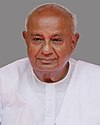United Front (India)
United Front | |
|---|---|
| Abbreviation | UF |
Andhra Pradesh Bhavan, New Delhi | |
The United Front was a
Background
The Indian general election in 1996 returned a fractured verdict. With the Bharatiya Janata Party emerging as the largest party with 161 of 543 seats, it was invited first to form a government. It accepted the offer, and Atal Bihari Vajpayee was sworn in as the prime minister. However, he was unable to get a majority in parliament, and the government dissolved 13 days later.[5] At a meeting of all the other parties, the Indian National Congress, with a substantial 140 seats, declined to head the government and agreed to extend outside support to the coalition,[6] whereas the Communist Party of India (Marxist) agreed to join the coalition with the Janata Dal at its head,[7] named the United Front.
With the approval of the Congress and CPI(M), the sitting chief minister of
Electoral performance
| Year | Legislature | Coalition leader | Seats won | Change in seats | Percentage of votes |
Vote swing | Outcome | Ref. |
|---|---|---|---|---|---|---|---|---|
| 1996 | 11th Lok Sabha | N. Chandrababu Naidu | 305 / 543
|
56.31% | Government | [14] | ||
| 1998 | 12th Lok Sabha | 88 / 543
|
20.98% | Opposition | [15] |
List of prime ministers
| No. | Portrait | Name | Term in office | Lok Sabha | Cabinet | Constituency | Party | |||
|---|---|---|---|---|---|---|---|---|---|---|
| Start | End | Tenure | ||||||||
| 1 | 
|
H. D. Deve Gowda | 1 June 1996 | 21 April 1997 | 324 days | 11th | Deve Gowda | Rajya Sabha Karnataka |
Janata Dal | |
| 2 | 
|
Inder Kumar Gujral | 21 April 1997 | 19 March 1998 | 332 days | Gujral | Rajya Sabha Bihar | |||
Coalition members
| Party | 1996 (Post-poll alliance) |
1998 (Pre-poll alliance) |
Seat Change | |
|---|---|---|---|---|
| Internal support | ||||
| Asom Gana Parishad | 5 | 0 | ||
| Communist Party of India | 12 | 9 | ||
| Communist Party of India (Marxist) | 32 | 32 | ||
| Dravida Munnetra Kazhagam | 17 | 6 | ||
| Janata Dal | 46 | 6 | ||
| Samajwadi Party | 17 | 20 | ||
| Tamil Maanila Congress | 20 | 3 | ||
| Telugu Desam Party | 16 | 12 | ||
| External support | ||||
| Indian National Congress | 140 | |||
| Total | 305 | 88 | ||
References
- ISBN 978-81-7099-711-5. Retrieved 10 December 2010.
- ^ "Chandrababu Naidu: Coalitions have delivered clear policies". The Indian Express. 2018-10-28. Retrieved 2022-11-12.
- ^ Service, Indo-Asian News (2022-04-20). "Andhra Pradesh: Naidu turns 72, gears up for another poll battle". The Siasat Daily. Retrieved 2022-11-12.
- ^ "Routed in many of its strongholds, Third Force loses its pan-Indian identity". India Today. Retrieved 2022-11-29.
- ^ "When Atal Bihari Vajpayee Became The Prime Minister For 13 Days And Then 13 Months". India.com. 2018-08-16. Retrieved 2022-12-26.
- ^ "Mamata Banerjee Can Say No UPA Anymore but Her National Goals are Tied to Congress' Future". News18. 2021-12-03. Retrieved 2022-12-26.
- ^ Kumar, Arvind (2022-08-19). "What Left parties' decision to not join Bihar alliance means for India's Dalits, women, MBCs". ThePrint. Retrieved 2022-12-26.
- ^ "Why Jyoti Basu could not be PM". Times of India Blog. 2010-01-10. Retrieved 2022-12-26.
- ^ Mukul, Akshaya. "Historic blunder: How hardliners denied Basu the chance to be PM". The Economic Times. Retrieved 2022-12-26.
- ^ "25 years ago HD Deve Gowda took oath as PM; JDS highlights achievements". www.business-standard.com. Press Trust of India. 2021-06-01. Retrieved 2022-12-26.
- ^ "Elections '98: United Front confident of good performance in coming polls". India Today. Retrieved 2022-12-26.
- ^ "Third Front | Alternative political combination and its challenges". Moneycontrol. 11 April 2022. Retrieved 2022-11-12.
- ^ "Chandrababu Naidu 2.0: Can he recreate 1996 in 2019 in the Capital?". Hindustan Times. 2018-11-10. Retrieved 2022-12-26.
- ^ Election Commission 1996.
- ^ Election Commission 1998.
